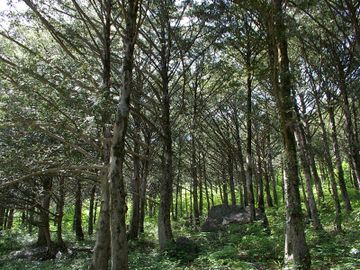"고흥 금탑사 비자나무 숲"의 두 판 사이의 차이
(→영문) |
(→영문) |
||
| 36번째 줄: | 36번째 줄: | ||
'''Forest of Japanese Torreyas at Geumtapsa Temple, Goheung''' | '''Forest of Japanese Torreyas at Geumtapsa Temple, Goheung''' | ||
| − | Japanese torreya (''Torreya nucifera'' (L.) Siebold et Zucc) is an evergreen coniferous tree in the yew family (Taxaceae). In Korea, it typically grows in the warm, southern coastal regions, including in Jeollanam-do and Gyeongsangnam-do Provinces, as well as on Jejudo Island. Its wood is used in construction, furniture making, and sculpture, and its fruits are used in the treatment of parasites and constipation. According to ''History of Goryeo'' (Goryeosa), in 1271, Korea sent Japanese torreya wood for the construction of palace buildings at the request of the Mongol Empire, while in the 1430s, the tree’s fruits were presented to the king | + | Japanese torreya (''Torreya nucifera'' (L.) Siebold et Zucc) is an evergreen coniferous tree in the yew family (Taxaceae). In Korea, it typically grows in the warm, southern coastal regions, including in Jeollanam-do and Gyeongsangnam-do Provinces, as well as on Jejudo Island. Its wood is used in construction, furniture making, and sculpture, and its fruits are used in the treatment of parasites and constipation. According to ''History of Goryeo'' (Goryeosa), in 1271, Korea sent Japanese torreya wood for the construction of palace buildings at the request of the Mongol Empire, while in the 1430s, the tree’s fruits were presented to the king as regional products. |
| − | This forest of Japanese torreyas located on the slope of Cheondeungsan Mountain near Geumtapsa Temple is presumed to have been planted around the 7th century when the temple was established to compensate for | + | This forest of Japanese torreyas located on the slope of Cheondeungsan Mountain near Geumtapsa Temple is presumed to have been planted around the 7th century when the temple was established to compensate for poor ''feng shui'' conditions through the tree’s fruits. All trees in the forest measure about 10 m in height and are presumed to have been planted around the same time. In recognition of its biological value as an old human-made forest with a history connected to a Buddhist temple, the forest was designated as a Natural Monument in 1972. |
===영문 해설 내용=== | ===영문 해설 내용=== | ||
2024년 7월 16일 (화) 11:28 기준 최신판
| 고흥 금탑사 비자나무 숲 Forest of Japanese Torreyas at Geumtapsa Temple, Goheung |
|
 고흥 금탑사 비자나무 숲, 국가유산포털, 국가유산청. |
|
| 대표명칭 | 고흥 금탑사 비자나무 숲 |
|---|---|
| 영문명칭 | Forest of Japanese Torreyas at Geumtapsa Temple, Goheung |
| 한자 | 高興 金塔寺 비자나무 숲 |
| 주소 | 전라남도 고흥군 포두면 금탑로 842 (봉림리) |
| 국가유산 종목 | 천연기념물 |
| 지정(등록)일 | 1972년 8월 2일 |
| 분류 | 자연유산/천연기념물/문화역사기념물/종교 |
| 수량/면적 | 131,086㎡ |
| 웹사이트 | 고흥 금탑사 비자나무 숲, 국가유산포털, 국가유산청. |
해설문
국문
금탑사 비자나무숲은 천등산(天燈山) 중턱에 있으며, 금탑사가 세워진 신라 선덕여왕 6년(637) 이후에 조성된 것으로 보고 있다. 숲을 이루는 나무의 높이는 10m 정도이고 모두 같은 시기에 심어진 것이다. 비자나무는 사찰 바로 앞에서부터 시작하여 사찰의 후방까지 밀림을 형성하고 있다.
비자나무는 주목과의 식물로 우리나라의 내장산 이남과 일본 등 극동지역에만 분포하는 특산 수종으로 열매는 구충제나 구황식물로 사용하고, 목재는 고급 용재로 궁궐 건축재 및 선박 제조용으로 이용하여 왔기 때문에 고려조 이전부터 국기에서 관리해 왔다.
『고려사』에 의하면, 고려 원종 11년(1271) 몽고에서 궁실 건축자재로 비자나무(榧木)를 고려에 요구하여 강릉, 남해, 진도 등지에서 보내진 기록이 있고, 1430년대에는 비자나무 열매를 특산물로 바치기도 하였다.
금탑사 비자나무는 비자나무의 열매를 구충제로 이용함과 동시에 풍수적 결함을 보충하기 위한 방편으로 식재되었다.
한국의 자연유산 금탑사의 비자나무숲은 금탑사와 관련되어 심어진 것으로 보여 조상들의 문화생활의 일면을 볼 수 있는 오래된 인공림으로서 생물학적 보존가치가 높아 천연기념물로 지정되었다.
영문
Forest of Japanese Torreyas at Geumtapsa Temple, Goheung
Japanese torreya (Torreya nucifera (L.) Siebold et Zucc) is an evergreen coniferous tree in the yew family (Taxaceae). In Korea, it typically grows in the warm, southern coastal regions, including in Jeollanam-do and Gyeongsangnam-do Provinces, as well as on Jejudo Island. Its wood is used in construction, furniture making, and sculpture, and its fruits are used in the treatment of parasites and constipation. According to History of Goryeo (Goryeosa), in 1271, Korea sent Japanese torreya wood for the construction of palace buildings at the request of the Mongol Empire, while in the 1430s, the tree’s fruits were presented to the king as regional products.
This forest of Japanese torreyas located on the slope of Cheondeungsan Mountain near Geumtapsa Temple is presumed to have been planted around the 7th century when the temple was established to compensate for poor feng shui conditions through the tree’s fruits. All trees in the forest measure about 10 m in height and are presumed to have been planted around the same time. In recognition of its biological value as an old human-made forest with a history connected to a Buddhist temple, the forest was designated as a Natural Monument in 1972.
영문 해설 내용
비자나무는 주목과에 속하는 상록침엽교목으로, 한반도에서는 전라남도, 경상남도, 제주도 등 따뜻한 남부 지방에서 자란다. 목재는 건축재, 가구재, 조각재 등으로 많이 쓰이고, 열매는 구충제와 변비 치료제 등으로 쓰인다. 『고려사』에 따르면 1271년에 몽골제국의 요구에 따라 궁실 건축자재로 쓸 비자나무를 보낸 기록이 있고, 1430년대에는 비자나무 열매를 특산물로 바치기도 하였다.
천등산 중턱 금탑사 주변에 있는 비자나무 숲은 금탑사가 창건된 7세기 무렵에 비자나무의 열매를 이용하고 풍수적 결함을 보충하기 위해 조성된 것으로 추정된다. 숲을 이루고 있는 나무의 높이는 10m 정도이고 모두 같은 시기에 심어진 것으로 보인다. 사찰과 관련이 있는 오래된 인공림으로서 생물학적 보존가치가 높아 1972년 천연기념물로 지정되었다.
참고자료
- “몽고에서 건축자재와 희귀한 물품을 요구해오다”(1271년 06월 23일 (음)), 고려사, 국사편찬위원회 한국사데이터베이스. http://db.history.go.kr/id/kr_027r_0010_0060_0090